In each edition of Gimmick Some Lovin', we take a look at one iteration of a gimmick match available on the WWE Network. Some are iconic for their success, others for the extent to which they flopped, and some just... happened.
We defined a "gimmick match" as, in any way, adding a rule/stipulation to or removing a rule from a match, changing the physical environment of a match, changing the conditions which define a "win", or in any way moving past the simple requirement of two men/women/teams whose contest must end via a single pinfall, submission, count out, or disqualification.
NXT TakeOver: WarGames was special because, for the first time in nearly 20 years, two rings will be placed side-by-side, a cage will surround the pair, and three teams will engage in one of the most-requested matches fans thought they'd never actually see again: The War Games Match.
10 WWE Stars Who Are Now Banned - Find Out Now!
We look to the match's origins, with WarGames: The Match Beyond from the 1987 NWA Great American Bash, pitting the Four Horsemen (consisting of Ric Flair, Arn Anderson, Lex Luger, and Tully Blanchard, alongside their manager James J. Dillon) against the team of The Road Warriors (with their manager "Precious" Paul Ellering), Nikita Koloff, and, the mastermind behind the match itself, "The American Dream" Dusty Rhodes.
The Son of a Plumber vs. "The Man"
The origins of this match are twofold.
First is the longstanding feud between Rhodes and the leader of the Horsemen, Flair. Flair represented everything Rhodes was not: Flair was the millionaire playboy who bragged about all the expensive liquor he drank (and even more about the liquor he wasted), while Rhodes emphasized his hardscrabble Texas upbringing which led him to become a real man of the people.
Like with Mick Foley in our previous entry, the emphasis on Rhodes's everyman nature made his character resonate with fans like few others, as did his non-traditional look; "The American Dream" generally looked like he'd be just as much in his element chugging beers with the fans in the upper deck as he was enthralling those fans in the ring.
His antithesis was Flair, who made every effort to look and act like he spent more than those ticket-buyers made in a year on just getting to the arena and dressing for his match. Flair was the Tom Brady of his era: a man whose effortless good looks and skin-of-his-teeth victories earned him millions which he was not afraid to flaunt, and which made him the most hated man in the world for anyone outside of a handful of area codes.

The two iconic blondes clashed through much of the 1980s, trading the NWA World Championship on a few occasions, but the advantage always went to Flair because he had the power of his fit, wealthy, and bloodthirsty allies beside him in the Four Horsemen. The Horsemen frequently made Dream's life hell, even breaking Dusty's leg on one occasion (inspiring the famous "Hard Times" promo above), and his arm on another.
Fans everywhere ate it up and asked for seconds; in the era of Reaganomics, Dusty was the guy who worked next to every fan on the assembly line, while Flair and the Horsemen were the factory owner's entitled son(s) who inherited the business and based every decision not on how it benefitted the workers, but how it benefitted themselves.
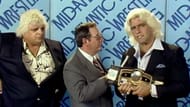
Dusty was Rocky, but Flair was Wall Street. Dusty was Springsteen-meets-Mellencamp, but Flair was The Rat Pack. Flair was the equivalent of travelling in a Lear Jet, but Dusty was the equivalent of road tripping with six friends to save on gas.
Dusty sees a movie and finds Gold
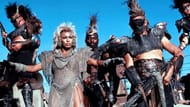
The character of "The American Dream" was never short on allies, but all too frequently alone when the Horsemen came to call. If Rhodes did manage to assemble a posse, the evil quartet always managed to escape intact, boiling fans' hatred across the South.
As Dusty tells it, he knew the match needed to be taken to a higher level. It needed a violent clash, but it couldn't be something the fans had seen before. The world needed to see Dream and his team of destroyers finally pay the Horsemen their comeuppance, but the most common speciality matches used as blowoffs in the era were paths too often trod in that program to up the ante.
Enter the second element crucial to the origins of the match: Mad Max Beyond Thunderdome, which Dusty attributes as the inspiration for a larger, roofed structure with literally no escape wherein the heels and faces would commit atrocities against one another until a member of one team admitted he could take no more.
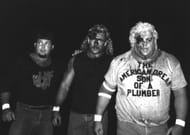
Dusty Rhodes, however, was no ordinary booker. He knew that just the concept of the match wouldn't draw the crowds in, and he understood that it needed a twist. Ergo, he decided that entry into the match would be staggered and, this being the NWA/Jim Crockett Promotions in the 1980s, the heels would begin with and generally always maintain the numerical advantage.
With the help of William "Klondike Bill" Soloweyko, a retired wrestler who was in charge of the physical setup of the physical setup of the company's arenas and rings, Dusty envisioned a larger-than-life setup of two rings enclosed in the largest roofed steel cage known to the wrestling business at the time.
The Rules
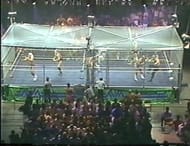
Each War Games Match seems to have its own minor tweaks to the rules, so we'll take a look at the rules for this particular contest, the first in its long history.
Three men would start the match: two members of a team who won the coin toss (which, in most incarnations of the match, would be the heels because of Dusty Rhodes) and one member of the opposing team. At regular intervals the teams would alternate sending a new man into the cage; no pinfalls or submissions would count during the War Games portion, and any assault was legal inside the cage.
Once both teams had all their men inside, The Match Beyond commenced, and the first team to force a member of the opposing team to submit or surrender would be declared the winners.
The Match
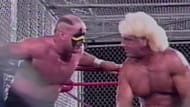
What sinks a lot of "bitter rivalries" in professional wrestling is the big match itself; while the men have been attacking each other and scrapping for weeks, months, even years, the very nature of a professional wrestling contest drains some of that bitterness by imposing the ballet-like traditions of a match on that hatred.
War Games is all hatred. It's all bitterness. Before the timeline ticker on the WWE Network hits three minutes, blood is already flowing from multiple men; by the end of the match, at least 60% of its combatants are shedding some of the red stuff. Announcer Jim Ross's voice is so hoarse once the finish arrives, I'm sure he'd have been coughing up a few pints himself.
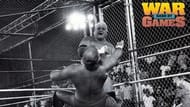
Most of the offence in this bout consists of punches, kicks, and the walls of the cage itself being turned into weapons, but even workrate marks couldn't complain at the artistry with which it's done. Suplexes and rest holds were not going to get the job done here. This match needed brutality, which it delivered in spades.
The two rings setup put a fantastic spin on traditional heel-face heat spots, giving extra ammunition to technicians like Arn Anderson and Tully Blanchard who, in tag team wrestling, were masters of cutting a single ring in half; a second ring earns an exponential increase in audience hatred for their actions. On the babyface side, meanwhile, Road Warrior Animal hits a beautiful flying shoulder block from one ring into the other early on, while he and Hawk would use the rings to isolate J.J. Dillon towards the end to their masterful (and crowd-pleasing) advantage.
Speaking of the crowd, their reactions are one of the best elements of the match. Every single time a babyface evens up the side, the fans react like a dog greeting its owner home from a business trip. Each and every time the Road Warriors or ex-Soviet Nikita Koloff proved themselves to be impervious to Flair's signature chest chops, the pop we discussed last week with Steve Austin's entry into the Raw title match gets put to shame.
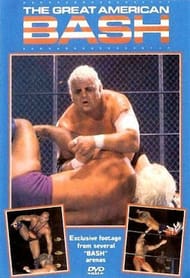
The closest thing to a fault to find in this match is the anticlimactic finish, which begins with the final two entrants into the contest: managers Dillon for the heel team and Paul Ellering for the faces. Dillon looked like the stereotype of the soft, privileged rich kid, down to his high-waisted briefs and pale, hairless body; the crowd literally salivates when he approaches the door because of the pain he was set to encounter. Then, with Ellering joining the fray, The Match Beyond commenced.
Ellering introduces the Road Warriors' decorative spikes as a weapon, and both heels and faces increase the bloodletting while the LOD demolishes Dillon in a separate ring. Hawk and Animal hit an improvised version of their traditional Doomsday Device tandem finisher; because of the low ceiling, the pair were unable to hoist Dillon to their shoulders or hit a true flying clothesline to knock him off, and Dillon hits the mat with a sickening thud.
As the battle commences around them, the Road Warriors continue to work Dillon against the side of the cage, before an official makes his way over on the outside and accepts Dillon's surrender to give the babyfaces the victory. Later War Games contests would more definitively end the contest with a dramatic submission finish, but this one strangely fizzles out before it becomes official (and the other seven combatants don't seem to get the memo at first that the bell has rung).
The drama, however, preceding that finish is so fantastic that picking apart those final moments is almost like finding the one or two camera angles in The Godfather that might have been slightly better.
My Rating
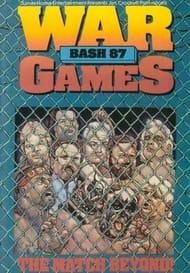
Picking apart the finish is pointless because the finish is the least important part of the match. It's not hyperbole to say that this is some of the best storytelling the men in this match have done in their careers.
Often, people are able to hide in multi-man matches, letting them coast on the accomplishments of the other performers in the ring(s). Nobody, however, hides in this one. Beyond the fact that the ring setup means that they can't, wrestlers are rarely inactive here and play up their biggest strengths.
Dusty takes a massive beating and keeps getting up, the LOD pummel and throw their opponents from one end of the structure to the other and through both rings, the heels use every dastardly trick available during their windows of numerical advantage, and Flair taunts, begs, cheap shots, and gyrates through a shower of blood with a level of charisma that even a massive cage cannot contain. Add in Koloff, redeemed from his dastardly days of heeldom, and the two managers, and not a single ingredient here is wasted.
It'll be hard to imagine WWE's reboot of the match coming even close to this match's use of the stipulation. There's a level of brutality on display that makes it seem like this one may not have been a work, and that intensity doesn't really seem to exist in the three-way feud between SAnitY, the Authors of Pain, and The Undisputed Era; even if it were, the company that stopped Samoa Joe vs. Finn Balor multiple times due to Joe's bleeding eye would surely not allow their match to rival this one's intensity (although the fact that it was booked by Triple H, the world's biggest fan of Dusty's booking, does show some promise).
9.75/10
Meltzer says
Meltzer gave five stars to the version of this one airing on the July 31, 1987, edition of the Great American Bash (that year it was a series of three events throughout the month of July), but I watched the July 4 edition; I'd wager his opinion of this one would be the same, but I'd need to further study that July 31 match to know for sure (the two teams are nearly identical, only with War Machine replacing Dillon).
Send us news tips at fightclub@sportskeeda.com
Make Sportskeeda your preferred choice for WWE content by clicking here: Source preferences

